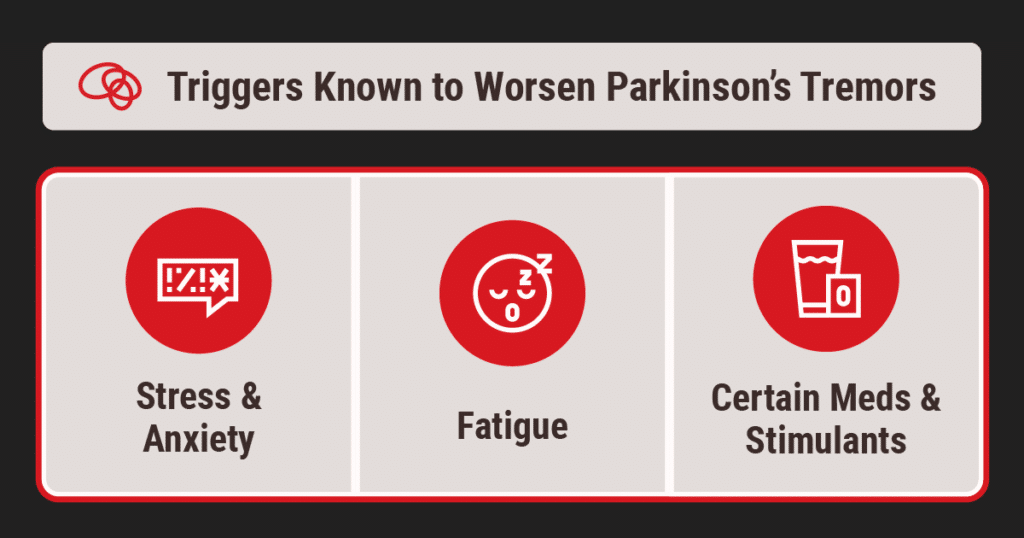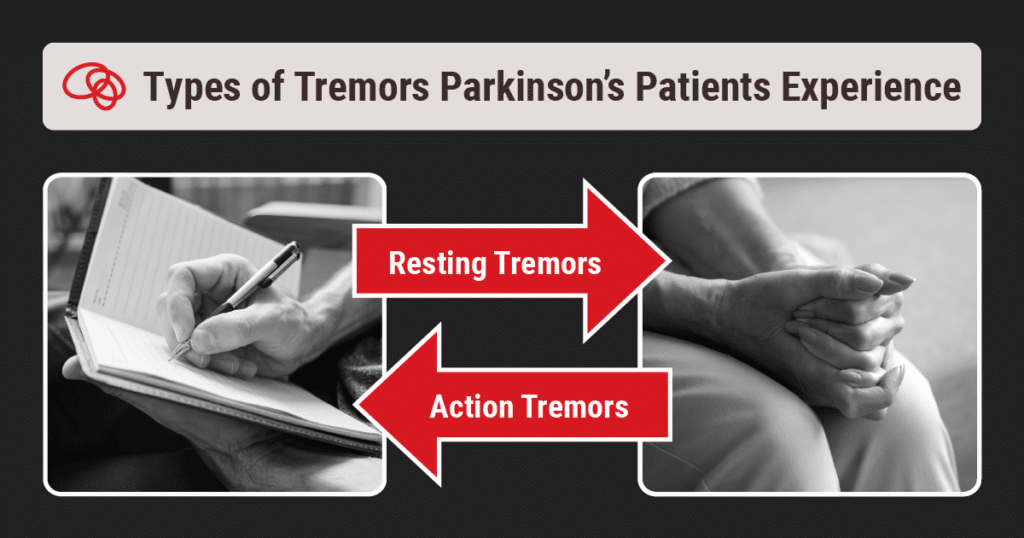Experiencing Tremors for the First Time Can Be Unsettling
It might start as a slight, uncontrollable shaking in your hand or another part of your body, almost like a quiver just beneath your skin. You may feel a sense of disbelief or confusion, as your body suddenly moves without your intent.
It’s not painful, but the loss of control can be startling and make you feel vulnerable. The tremor may come and go, leaving you wondering what just happened, and whether it will happen again.
If you’ve just started having tremors, learning how they work and what to expect can be empowering. It helps you manage them and stay in control of your life.
And if you’ve been diagnosed with Parkinson’s and you’re wondering when the tremors will start… well, they might not. Roughly 1 in 5 people with Parkinson’s don’t have tremors at all! Still, it can be useful to know what to watch for and how to make your life a bit easier if tremors do start.
Let’s dive in with some basic information about tremors and common questions that Parkinson’s patients often have.
Roughly 1 in 5 people with Parkinson’s don’t have tremors at all!
What is it like to have Parkinson’s tremors for the first time?
Most people don’t feel their first tremor — they don’t even realize it’s happening until they see it. And when they do, their reaction tends to be somewhere between confusion and surprise.
Here’s what some real patients have to say about their initial experience with tremors:
“For me it was looking at my thumb slightly trembling and going ‘huh, that’s strange.’ It wasn’t earth-shattering or horrible, just curious.”
“It was only noticed when looking at my left hand…my thumb and index finger looked like they were shivering a tiny bit. No feeling of the movement at all.”
“…it started with my index finger, but when I started tremors in my entire hand, I initially thought that it was too much caffeine. That’s what it felt like to me.”
How do other people react to tremors?
Here are some anecdotes on what patients have had to endure from the world at large:
“…one of my worst interactions so far was with the police officer who was convinced I was tweaking because my hand was shaking using the credit card reader at the gas station at 1am.
“I worry about getting pulled over and the anxiety of the situation kicking my tremors into full gear leading to the officer thinking must be on something.”
“My wife made herself a shirt for our last cruise. On the front it said[,] ‘I don’t have the drink package. I have Parkinson’s’. On the back it said ‘Or do I?’”
Yes, at times there will be some people who think you are drunk or on some kind of drug. Yes, you will run into those who look at you and treat you differently because of your tremors. It sucks.
But the vast majority of people, if you give them time and explain calmly and with good humor that you have Parkinson’s disease, will get over their confusion, suspicion, and discomfort (and sometimes annoying sympathy), and move on.
You will also find plenty of people with some knowledge and experience of tremors who will simply treat you like a human being who is going through something frustrating and wants it to be over.
Are specific parts of the body more prone to tremors?
Patients find that tremors often begin on one side of the body, most commonly in their hands or fingers. Over time, they may spread to your other side or affect other areas, such as your jaw, chin, lips, or legs.
As the disease progresses, these tremors can become more pronounced, potentially interfering with daily activities like dressing, eating, or even speaking.
What can worsen or “trigger” Parkinson’s tremors?
“When [I] get stressed my body will lock up. Even if I’m not stressed, when [I] really need to concentrate my body will lock up, although not as bad as if [I] was in an argument with someone. Frustration brings out the worst muscular symptoms.
Several factors can exacerbate Parkinson’s tremors, so it’s good to recognize and potentially avoid them if possible. This can help you manage your tremors more effectively.
Known triggers include:
- Stress and Anxiety. High stress levels or anxiety can make your tremors more severe.
- Fatigue. If you have trouble resting or are overly tired, it can make your tremors worse.
- Certain Medications and Stimulants. Some medications or substances — like caffeine — can increase the intensity of your tremors. It’s important to discuss all of your medications with your healthcare provider so that you understand their possible impact on your symptoms.

How do you slow down Parkinson’s tremors?
“The one thing proven to slow progression of the disease is exercise. Exercise as hard as you can for as long as you can…I was diagnosed with PD 10 years ago and I am still working and traveling for both business and pleasure.”
To slow down Parkinson’s tremors, a multifaceted approach is typically recommended, involving medication, lifestyle changes, and sometimes surgical interventions.
Do Parkinson’s tremors ever go away?
Parkinson’s tremors typically do not go away completely, as they are a core symptom of Parkinson’s disease, which is a progressive neurological disorder. However, tremors can often be managed or reduced with the right treatment plan.
Can you “distract” your tremors?
“A key feature with diagnosing Parkinson’s is to check if the tremor is distractible. If it is, then that’s inconsistent with PD and may indicate a functional neurological disorder. PD patients can often stop their tremor temporarily by moving the limb that tremors but not by moving or focusing on other limbs or tasks[.]
There are countless anecdotal reports of Parkinson’s patients who are able to temporarily halt their tremors by concentrating on it or by moving the limb experiencing tremors. However, those stories almost say that the tremors return the moment they stop moving or paying attention.
Are there different kinds of tremors that people experience with Parkinson’s?
That’s right. There are actually two different kinds of tremors you will likely experience.
Resting Tremors
This is the most common type of tremor associated with Parkinson’s. It occurs when the muscles are at rest, such as when your hands are lying in your lap. When you move the affected body part, this type of tremor typically decreases, and may even stop altogether.
Action Tremors
While less common in Parkinson’s, action tremors occur when the affected body part is already in motion. For example, you might suddenly experience shaking in your hand in the middle of writing, typing, or eating. As you might imagine, this can be incredibly frustrating and make what were previously routine tasks much more challenging.

What can be done to calm or treat Parkinson’s tremors at home?
“Four things you can do…1. Exercise. A lot…2. Reduce stress…Laugh, play, practice a glass half full attitude until you’re a real live, honest to goodness optimist…3. Sleep…4. A good diet like Mediterranean.”
There are certain lifestyle adjustments you can make to help with your tremors:
Manage Your Stress. Is there anything more stressful than someone telling you that you need to destress? Still, it’s true — tremors can be exacerbated by stress, so practicing relaxation techniques such as meditation, yoga, or deep breathing exercises can help minimize this.
Use Weighted Utensils. Invest in weighted utensils or wrist weights to help steady your hands while eating or performing fine motor tasks.
Try Adaptive Clothing. Wear clothing with Velcro, magnetic closures, or easy-to-grip zippers to make dressing easier and less frustrating.
Engage in Hand Exercises. Regularly practice hand and finger exercises, like squeezing a stress ball or doing gentle stretching, to improve dexterity and control.
Prioritize Hydration and Nutrition. Staying hydrated and eating a balanced diet can support overall health and may help reduce tremor severity.
Get Regular Exercise. Engaging in regular physical activity can improve overall motor function and might also reduce the intensity of your tremors. Rock Steady Boxing is one well-known organization that was created to further an exercise regimen designed specifically for people with Parkinson’s.
Practice Healthy Sleep Habits. Ensuring adequate sleep can make a significant difference in tremor management. This means creating a consistent sleep routine that includes going to bed at the same time, avoiding screens for at least an hour before bed, avoiding caffeine and other stimulants from mid-afternoon on, and doing whatever else helps you relax and get your body ready for sleep.
Break Tasks into Smaller Steps. Divide complex tasks into smaller, more manageable steps. This will allow you to focus and reduce the strain of doing too much at once.
Experiment with Tremor-Reducing Positions. Some people find that certain body positions, like holding objects close to the body or using both hands, can minimize tremors.
Use Adaptive Technology. Voice-activated devices and smart home technology can help reduce the need for fine motor control, making daily tasks easier.
Stay Socially Active. Engage in social activities that you enjoy. Staying connected with others can improve your mood and reduce the stress that may exacerbate tremors.
Avoid Stimulants in General. Skipping caffeine and other stimulants after a certain point in the day is a smart idea for everyone. But since some stimulants can increase your tremors’ intensity, it’s a good practice for you to reduce the amount of stimulants you consume in general. (Sorry, coffee lovers!)
Schedule Rest Breaks. Incorporate short breaks into your daily routine to avoid fatigue, which can worsen tremors.
Use Pill Organizers. To ensure you stick to your medication schedule, use a pill organizer with alarms or a smartphone app to remind you to take your medications on time.
What are the medical options for dealing with Parkinson’s tremors?
Beyond lifestyle changes, there are a variety of medical approaches that can help you in managing your tremors. Here are some of the most common approaches:
Medications. Drugs like levodopa, dopamine agonists, and anticholinergics can help control tremors. However, their effectiveness and side effects vary widely among patients. Regular consultations with your neurologist are essential to adjust dosages and explore alternatives if needed.
Deep Brain Stimulation (DBS). If you don’t respond well to medication, DBS may be an option. This surgical procedure involves implanting electrodes in specific parts of your brain to regulate abnormal impulses. This has been shown to significantly reduce tremors for many patients.
Physical Therapy. Research has found that improving muscle strength, flexibility, and balance, may reduce the severity of tremors. It’s different for everyone, but a tailored exercise regimen can be incredibly beneficial.
Occupational Therapy. Occupational therapists can provide practical solutions for the daily challenges caused by your tremors. This might include teaching you techniques that allow you to complete tasks more easily or recommending adaptive tools that can make activities like eating, writing, or dressing simpler.
Movement disorder specialist. What’s a movement disorder specialist? Essentially, they’re neurologists who have had extra training in movement disorders, including Parkinson’s. Because of their additional, specialized training, movement disorder specialists provide advanced care and tend to be equipped than neurologists in regards to making sure the medication you receive is tailored to your specific situation. They are also trained in advanced treatment options you might not be able to get elsewhere and understand how to identify and manage non-motor symptoms.
Additionally, if tremors start to significantly interfere with your daily life or if you notice a sudden worsening of symptoms, it’s important to consult your neurologist as soon as possible. Regular check-ups are essential for monitoring the progression of the disease and adjusting treatment plans as needed.
What options are out there to help Parkinson’s patients cope with tremors?
“I still have bad days…when I don’t want to get off the couch. Those days are the days that I rely on the people and tools I’ve surrounded myself for when I need an energy boost or an emotional pickup…It takes some work, years for some people, but with the right therapist/guide you can do this! And by all means, get off that friggin couch if you can!”
Living with tremors is awful. Period. People with Parkinson’s often report feeling frustrated or embarrassed, and in severe cases even attempting to complete everyday tasks can leave patients exhausted and defeated.
If you find yourself experiencing these emotions, it’s important to remember that you’re not alone. Support from family, friends, or Parkinson’s support groups can provide much-needed emotional relief. Additionally, counseling or therapy can help manage the psychological aspects of living with tremors, offering strategies to cope with the emotional toll of the disease.





